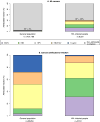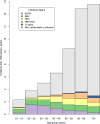Cancers attributable to infections among adults with HIV in the United States
- PMID: 26182198
- PMCID: PMC4636914
- DOI: 10.1097/QAD.0000000000000808
Cancers attributable to infections among adults with HIV in the United States
Abstract
Objective: HIV-infected people are at increased risk of cancers of infectious origin. We estimated the burden of cancer attributable to infections among HIV-infected people in the United States in 2008.
Design: Incidence rates for cancer sites associated with infections were estimated from record linkage between HIV/AIDS registries and cancer registries.
Methods: Rates were applied to estimates of the population living with diagnosed HIV in the United States in 2008 to obtain the number of incident cancer cases. Site-specific attributable fractions and corresponding 95% confidence intervals (CIs) were estimated from infection prevalence among cancer cases. Infection prevalence data were derived from literature review of case series.
Results: Of an estimated 6200 incident cancer cases (95% CI 6000-6500), 2500 (95% CI 2400-2700) were attributable to infection (attributable fraction = 40%, 95% CI 39-42). The most important infections were Kaposi sarcoma herpes virus, Epstein-Barr virus, and human papillomavirus, which together were responsible for 2200 new cancer cases (95% CI 2100-2400), mainly Kaposi sarcoma, lymphomas, and ano-genital cancers. The attributable fraction in HIV-infected people was highest in the age group 20-29 years (69%, 95% CI 65-72). MSM were the HIV transmission group with the highest attributable fraction (48%, 95% CI 46-50), due to the high incidence of both Kaposi sarcoma and anal cancer.
Conclusion: The very high fraction of cancer attributable to infection in HIV-infected people points to special opportunities to prevent these cancers, that is, avoidance, detection, and early treatment of cancer-associated infections, and universal early detection and uninterrupted treatment of HIV infection to avoid immunosuppression.
Conflict of interest statement
The authors have no conflict of interest to declare.
Figures


Similar articles
-
Cancer risk in HIV-infected people in the USA from 1996 to 2012: a population-based, registry-linkage study.Lancet HIV. 2017 Nov;4(11):e495-e504. doi: 10.1016/S2352-3018(17)30125-X. Epub 2017 Aug 10. Lancet HIV. 2017. PMID: 28803888 Free PMC article.
-
Cancer burden in the HIV-infected population in the United States.J Natl Cancer Inst. 2011 May 4;103(9):753-62. doi: 10.1093/jnci/djr076. Epub 2011 Apr 11. J Natl Cancer Inst. 2011. PMID: 21483021 Free PMC article.
-
Deaths Attributable to Cancer in the US Human Immunodeficiency Virus Population During 2001-2015.Clin Infect Dis. 2021 May 4;72(9):e224-e231. doi: 10.1093/cid/ciaa1016. Clin Infect Dis. 2021. PMID: 32710777 Free PMC article.
-
Estimated economic burden of genital herpes and HIV attributable to herpes simplex virus type 2 infections in 90 low- and middle-income countries: A modeling study.PLoS Med. 2022 Dec 15;19(12):e1003938. doi: 10.1371/journal.pmed.1003938. eCollection 2022 Dec. PLoS Med. 2022. PMID: 36520853 Free PMC article.
-
Burden of Kaposi sarcoma according to HIV status: A systematic review and global analysis.Int J Cancer. 2022 Jun 15;150(12):1948-1957. doi: 10.1002/ijc.33951. Epub 2022 Feb 16. Int J Cancer. 2022. PMID: 35085400
Cited by
-
Strategies for Targeting Retroviral Integration for Safer Gene Therapy: Advances and Challenges.Front Mol Biosci. 2021 May 12;8:662331. doi: 10.3389/fmolb.2021.662331. eCollection 2021. Front Mol Biosci. 2021. PMID: 34055882 Free PMC article. Review.
-
Cancer risk following lymphoid malignancies among HIV-infected people.AIDS. 2020 Jul 1;34(8):1237-1245. doi: 10.1097/QAD.0000000000002528. AIDS. 2020. PMID: 32287068 Free PMC article.
-
Risk of Cancer among Commercially Insured HIV-Infected Adults on Antiretroviral Therapy.J Cancer Epidemiol. 2016;2016:2138259. doi: 10.1155/2016/2138259. Epub 2016 Nov 2. J Cancer Epidemiol. 2016. PMID: 27882054 Free PMC article.
-
The role of viruses in HIV-associated lymphomas.Semin Hematol. 2022 Oct;59(4):183-191. doi: 10.1053/j.seminhematol.2022.11.002. Epub 2022 Dec 1. Semin Hematol. 2022. PMID: 36805886 Free PMC article.
-
CD4/CD8 Ratio and Cancer Risk Among Adults With HIV.J Natl Cancer Inst. 2022 Jun 13;114(6):854-862. doi: 10.1093/jnci/djac053. J Natl Cancer Inst. 2022. PMID: 35292820 Free PMC article.
References
-
- IARC. Monographs on the Evaluation of Carcinogenic Risks to Humans Volume 100B : A Review of Human Carcinogens: Biological Agents. Lyon: International Agency for Research on Cancer; 2012.
-
- Clifford GM, Rickenbach M, Polesel J, Dal Maso L, Steffen I, Ledergerber B, et al. Influence of HIV-related immunodeficiency on the risk of hepatocellular carcinoma. Aids. 2008;22:2135–2141. - PubMed
-
- Strickler HD, Burk RD, Fazzari M, Anastos K, Minkoff H, Massad LS, et al. Natural history and possible reactivation of human papillomavirus in human immunodeficiency virus-positive women. J Natl Cancer Inst. 2005;97:577–586. - PubMed
-
- Sullivan SG, Hirsch HH, Franceschi S, Steffen I, Amari EB, Mueller NJ, et al. Kaposi sarcoma herpes virus antibody response and viremia following highly active antiretroviral therapy in the Swiss HIV Cohort study. Aids. 2010;24:2245–2252. - PubMed
-
- Clifford GM, Polesel J, Rickenbach M, Dal Maso L, Keiser O, Kofler A, et al. Cancer risk in the Swiss HIV Cohort Study: associations with immunodeficiency, smoking, and highly active antiretroviral therapy. J Natl Cancer Inst. 2005;97:425–432. - PubMed
Publication types
MeSH terms
Grants and funding
LinkOut - more resources
Full Text Sources
Medical

